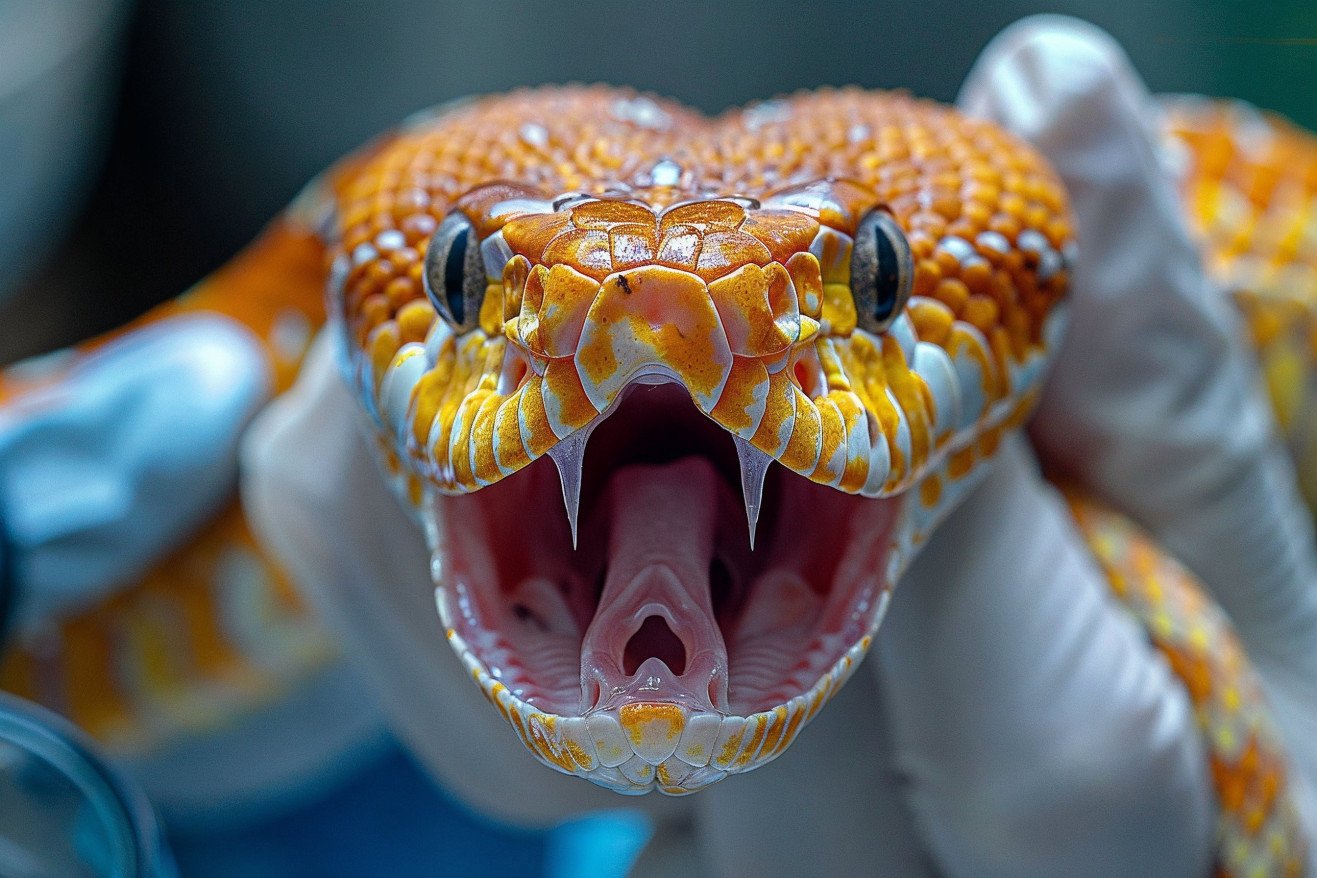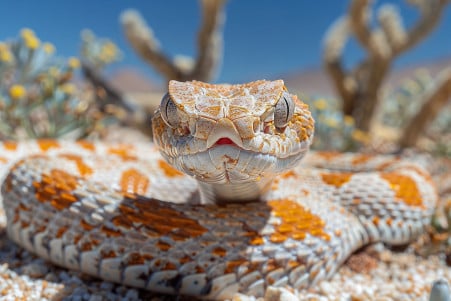How Many Teeth Do Snakes Have? An Inside Look at Their Teeth
13 March 2024 • Updated 12 March 2024

Snakes are often celebrated for their elegant movement, but have you ever stopped to think about what’s going on inside those mysterious mouths? It turns out that all snakes have teeth, and they tend to be long and curved. However, the number and arrangement of teeth can vary widely between species, and unlike mammals, snakes don’t have teeth that are embedded in sockets.
Instead, their teeth are attached to the jawbone. They also don’t use their teeth to chew their prey.
This article will take a deep dive into the world of zoological and veterinary research to uncover the many details of snake teeth. From the different types of teeth to the ways that they’re adapted to help snakes eat and deliver venom, we’ll explain the biological reasons for these unique reptilian dental features.
By looking at the latest research, we hope to give you a thorough understanding of how snakes’ teeth work, and in the process, deepen your understanding of these mysterious animals.
How many teeth do snakes have?
The Evolution of Snake Teeth
The diversity of snake dentition is a clear indication of the wide range of hunting and feeding strategies that different species have evolved. The four main types of snake teeth—aglyphous, opisthoglyphous, proteroglyphous, and solenoglyphous—each have different structures and functions. For example, aglyphous teeth, like those of the Burmese Python, are all the same size and shape, which is well-suited for grasping and holding prey.
Opisthoglyphous snakes, such as the Hog Nose Snake, have rearward-pointing teeth in the back of the mouth that are used to deliver venom, which means the snake must position the prey in a specific way to deliver the venom.
Proteroglyphous snakes, like the Texas Coral Snake, have fixed front fangs that deliver a potent venom. Meanwhile, the Gaboon viper has hinged solenoglyphous fangs that can open wide, allowing it to deliver a large amount of a less potent venom in a single bite.
Aglyphous teeth are also used by non-venomous snakes, which use constriction rather than venom to kill their prey, to capture and hold their prey. This is an important adaptation for these snakes, and it’s clear that the structure of snake teeth is closely related to their diet. For example, pythons, which constrict their prey, have solid, backward-pointing teeth that are used for grasping rather than venomous fangs.
In addition, snakes replace their teeth throughout their lives, which is an adaptation that ensures that they have effective teeth for capturing and eating prey. This constant replacement of teeth is a sign of the evolutionary success of snake dentition, which has evolved to meet the many different feeding strategies and ecological niches that snakes have evolved to fill.
The Serpentine Smile: Snake Teeth and Diet
The evolutionary arms race between predators and prey is especially complex for snakes, given the important role that dentition plays in their feeding habits.
Snakes have evolved a variety of tooth types to accommodate different kinds of prey, and this is a classic example of the relationship between an animal’s form and function.
A paper in PLoS Biology shows that the radiation of snakes after the Cretaceous–Paleogene extinction event was associated with a major increase in dietary specialization, and the teeth and fangs of snakes became increasingly specialized to their prey, from the holding teeth of constrictors to the hollow fangs of venomous snakes.
The role of teeth in snake ecology is also shown by changes in behavior after feeding. A paper in PMC on the brown treesnake demonstrates that snakes reduce their activity and change their habitat use after eating large prey, which has implications for their detectability and management in the wild. This reliance on their dental armament for subduing prey means that they must rest to effectively digest their meals.
Moreover, the paper Feeding in Snakes: Form, Function, and Evolution of the Feeding System explains that snakes are gape-limited predators, meaning that their options for prey are limited by the size and shape of their heads. The specialized adaptations of snake teeth are not just important for the immediate task of feeding, but are also central to their broader ecological roles, which determine their survival and their place in ecosystems.
The Evolution of Snake Teeth
The complex nature of snake teeth is the result of a long evolutionary history. A study in Evolution demonstrates how snake fangs have evolved to match the prey preferences of different snake lineages. This specialization has led to an incredible diversity of fangs and venom systems, with vipers and atractaspidids evolving long tubular fangs and elapids evolving shorter, fixed fangs.
A study on PubMed has shown that the evolution of both front and rear fangs in snakes is likely due to a common ancestral origin. This indicates a major evolutionary transition that has contributed to the great diversity of modern snakes. The close association of these fangs with venom glands has been a driving force in the evolution of snakes and has helped them become the successful predators they are today.
The study in Evolution also notes that convergent evolution has led snakes with similar diets to evolve similar fang morphologies, regardless of their evolutionary history. This demonstrates the flexibility and adaptability of snakes, as their teeth have continued to evolve in response to dietary and environmental factors.
The evolution of snake dentition has had far-reaching effects. As a study in BMC Ecology and Evolution points out, the evolution of venom and fangs allowed snakes to move away from constriction, which enabled them to exploit new ecological niches and prey.
This major innovation is thought to have driven the global diversification of snakes, making them one of the most diverse and widespread groups of reptiles. Knowing this evolutionary background not only helps us understand the past, but it also has implications for the conservation and medical research of these amazing reptiles.
The Deadly Connection: Venom and Snake Dentition
Nature’s syringes, venomous snake fangs, have evolved to deliver a lethal cocktail of toxins with incredible precision. From fixed to hinged, the shape of these fangs is closely related to the snake’s venom. According to Archives of Toxicology, snake venom is made up of a complex mixture of as many as 42 different protein families. However, four main protein families are responsible for the clinical effects of envenomation, which include coagulopathy and neurotoxicity.
The variety of venom is extensive, with each snake species having a venom that’s tailored to its fang type. According to PNAS, venom composition is determined by genomic and postgenomic factors, which lead to clinically important differences that affect the efficacy of antivenom. This complex relationship between fang shape and venom function shows the importance of the exact adaptations in snake dentition.
According to PMC, snake venom has a wide range of biomedical uses; venom peptides are used for biodiscovery and are even being considered as possible therapeutics.
By understanding the relationship between snake fangs and venom, medical science can be advanced and the survival of these reptiles and the people who live near them can be ensured. This connection between venom, dentition, and the environment is a perfect example of the adaptability of snakes in their natural environments.
The Secret World of Snake Teeth: A Recap
In the reptile world, snakes are unique for their wide variety of tooth arrangements, from the simple aglyphous to the complex solenoglyphous dentition. Our exploration of the many different types of snake teeth has shown that each type of tooth is highly specialized to the snake’s lifestyle and diet. The close relationship between snake teeth and feeding strategies is a clear indication of the complexity of snake evolution and their impact on the environment.
The evolutionary story of snake teeth is one of adaptation and success, showing how snakes have evolved a wide variety of specialized tooth arrangements through changes in diet and environment. Venom, which is used by many snakes to subdue their prey, has evolved in concert with snake dentition to make snakes formidable predators and defenders.
The importance of understanding snake teeth for both ecological and biomedical reasons goes beyond just being interesting, as we have seen. It is essential that researchers continue to study snake teeth to help with conservation and medical research, especially in the development of antivenoms.
In summary, the amazing diversity of snake dentition is an affirmation of the adaptability and success of snakes in a wide range of environments around the world, and it is an affirmation of the enduring legacy of these amazing reptiles.


